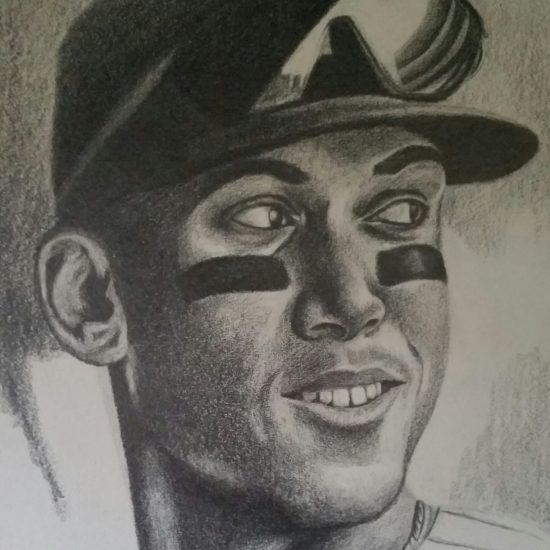This past offseason, Pitcher List introduced Pitch Level Value, or PLV, a new metric that assesses player performance by grading outcomes on the single pitch level. If you’re new to it, you can read Nick Pollack’s primer on PLV here.
You’ll find the definitions below. Grades are on a 20-80 scale.
Swing Aggression: How much more often a hitter swings at pitches, given the swing likelihoods of the pitches they face.
Strikezone Judgement: The “correctness” of a hitter’s swings and takes, using the likelihood of a pitch being a called strike (for swings) or a ball/HBP (for takes).
Decision Value (DV): Modeled value (runs per 100 pitches) of a hitter’s decision to swing or take, minus the modeled value of the alternative.
Contact Ability: A hitter’s ability to make contact (foul strike or BIP), above the contact expectation for each pitch.
Power: Modeled number of extra bases (xISO on contact) above a pitch’s expectation, for each BBE.
Hitter Performance (HP): Runs added per 100 pitches seen by the hitter (including swing/take decisions), after accounting for pitch quality.
Pitch Level Value (PLV): Estimated value of all pitches, based on the predicted outcome of those pitches (0-10, 5 is league average).
Pitch Level Average (PLA): Value of all pitches (ERA Scale), using IP and the total predicted run value of pitches thrown.
Pitch type PLA: Value of a given pitch type (ERA scale), using total predicted run values and an IP proxy for that pitch type (pitch usage % x Total IP).
(Note: All PLV data is current through Thursday, 6/28).
Blake Snell has been a man on a mission; Over his last six starts, he has a 0.73 ERA and 0.73 WHIP with 60 Ks over 37 IP. Do you remember when he had a 5.48 ERA and 1.78 WHIP through his first five starts? If anything, it’s one of the many examples that illustrate how quickly we can end up chasing our tails by overreacting to small samples. But that’s the great game of fantasy; At what point do we know whether something is real or not?
The interesting thing about Snell’s recent dominance is that at least part of it has been fueled by his changeup. In his latest start against the Pirates, his fourth consecutive double-digit strikeout performance in a row, it returned a 0.85 PLA and 53.6% CSW (28 pitches). Overall, the change leads his arsenal with a 5.57 PLV and 2.20 PLA.
Among pitchers with at least 1,000 pitches thrown, Snell’s changeup PLA of 2.20 ranks tenth, just behind Zac Gallen (2.17).
The curveball has been his second-best pitch via PLV.
Last year’s version of Snell was a little different. Take a look.
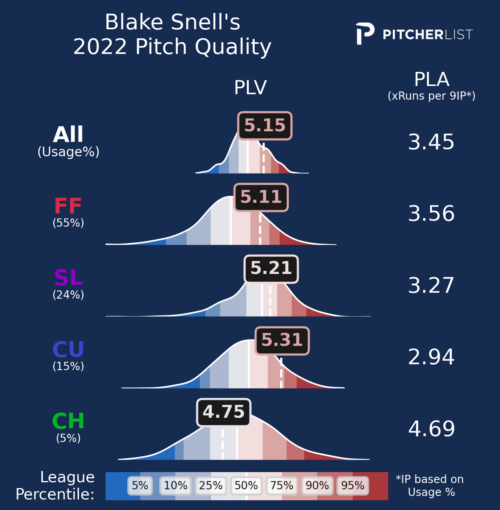
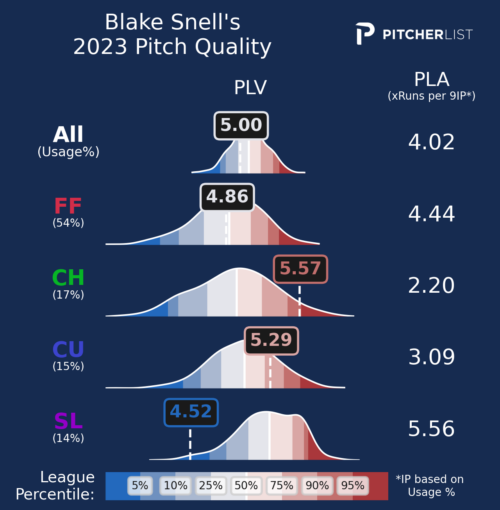
The changeup was his worst pitch and he only threw it at 5%. Now, he’s tossing it at 17% and it’s impossible to argue against the strategy given the beautiful results. The slider was his primary offspeed pitch last year; This year, it’s been easily his worst pitch.
As you can see above, his fastball has graded out significantly worse this year. I tend to think of changeups and fastballs as operating off of each other, so when I saw his changeup’s SwStr% of 27.6% (17.6% last year), I guessed that maybe his fastball whiff rate was up too. But that’s not the case at all; His heater has returned just a 7.3% SwStr %, down from 10.6%. Either way, it’s interesting to see the great results despite his fastball grading as below average.
Lucas Giolito has also enjoyed June; Through five starts, he has a 2.32 ERA and 0.97 WHIP while also striking out hitters at a 31.2% clip. We’ve seen his slider pick up steam. In his latest start against the Angels, the slider (30 pitches) returned a 5.48 PLV / 1.96 PLA. The change (26 pitches) was brilliant, too, with a 5.79 PLV / 1.19 PLA.
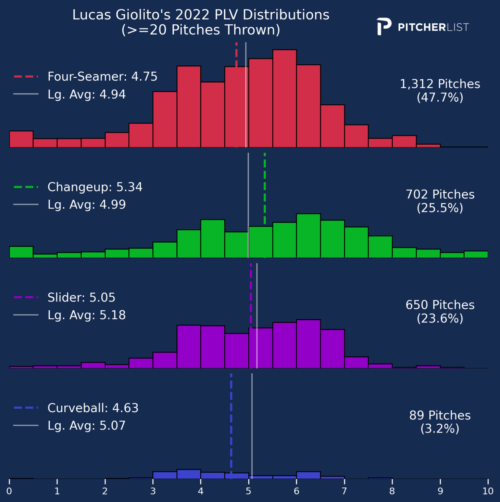
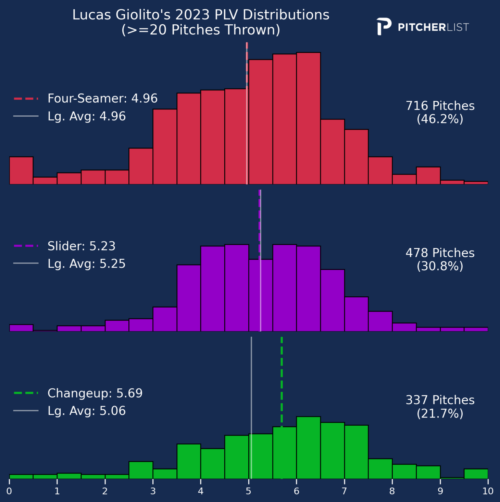
As you can see with his pitch distributions above, all three of his main pitches have taken a step forward, most notably the change; It’s 1.60 PLA is third among all pitchers with at least 1,000 pitches trailing only Michael Wacha (1.19), and Bailey Ober (1.52).
Harper has a .763 OPS through 48 games since returning from Tommy John surgery, which would be a career-low. He’s shown a little less swing aggression at 7.8% (11.9% last year), which has helped his walk rate. The home runs haven’t been there yet, but his power (60) isn’t all that far off from last year (65). The notable change is that his contact grade has dipped from 50 to 40. But that has been trending up slowly.

He’s actually shown better SZ Judgement (60) and Decision Value (55) compared to last year (55 and 45, respectively). I wouldn’t be worried about his outlook; If anything, he seems like a pretty decent buy-low.
While Harper’s production has been a little slow, the Phillies have gotten a boost from Castellanos, who is hitting .309 with a .846 OPS. Compared to last year, he’s shown a notable bump in DV from 40 to 50. However, despite being three home runs away from tying last season’s home run total (13), his power grade (50) is exactly the same as last year. During his big 2021 with the Reds (.938 OPS), his power graded out at 60, so he’s not quite at that level.
The 30-year-old Cuban is in the middle of a career year with a .843 OPS helping the Rangers blossom as one of baseball’s best offenses. The notable change from García has been a drop in swing aggression from 6% to 0.7%. The more selective approach is reflected by a big bump in DV from 40 to above league average at 55.
After a career-high 32 home runs, Tellez has been one of the year’s biggest disappointments so far. While his power hasn’t measured as well this year (50) compared to last year (65), the more interesting thing might be his swing aggression dropping from -3.2% all the way to -10%; That’s approaching Daniel Vogelbach’s level of inertness. This is the fourth year in a row that Tellez’s swing rate has dropped, and it’s hard not to think it’s hurting him right now. But I think we might be seeing his swing rate start to creep back up, so I’m a little interested to see if he rebounds from here.
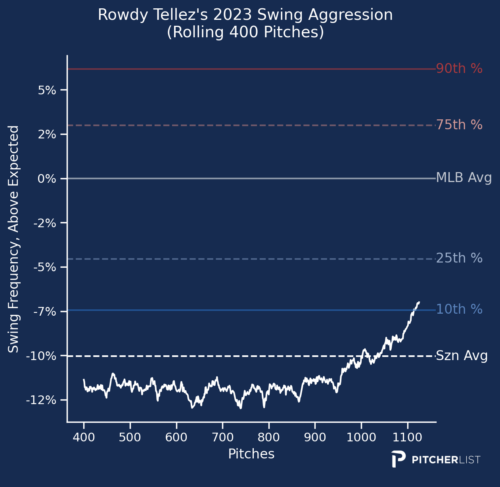
Kimbrel’s strikeout rate has soared to 39.8% compared to 27.7% last year. Kimbrel’s fastball performed well last year, but his curveball trended more toward the league-average range. That is not the case this year, as the pitch has come alive with a 5.45 PLV/ 2.50 PLA.
Last year, Benson showed improvement by cutting his K rate from over 30% to 22.7% in 89 games with Triple-A Columbus. After being traded to the Reds this offseason, he was squeezed for playing time early and got sent down. However, since being recalled in late May, he’s hit .278 with a .848 OPS. The sample size is flimsy (401 pitches) but he has flashed elite-level DV (75) with a 14.3% BB rate.
Whether or not he can keep the strikeouts down remains to be seen — Currently, his contact grades out below average at 40. This year, his K rate crept up to 26.3% with Triple-A Louisville, so I’m skeptical if he can; He might have the sort of passive approach (-7.6% swing aggression) that leads to a lot of strikeouts. Still, he has a lot of raw power and swiped 11 bags in 28 games with Louisville, so he’s worth keeping a close eye on as we get a better sample.
I’ll admit, I was very excited about Volpe heading into the year and still am, so I’m more than likely grasping for straws at this point. However, he’s hitting .343 with a .938 OPS over his last 12 games. As mentioned earlier, it’s often way too easy to get caught chasing small samples. But I am interested because it looks like he’s changing his approach by swinging more often.

Could this be a product of the infamous chicken parm film session? I don’t know, but it’s enough to pique my interest in the small hope for a big second half. Contact (40) remains the issue, but his power (55) has trended up.
Speaking of rookies, don’t give up on Casas yet. He’s hitting .380 with a .980 OPS over his last ten games. Sigh, small sample size again. Yes, I’m guilty! Anyway, Casas has shown off good SZ Judgement (55) and DV (60) with power (60). His one weakness is contact (40). But that has been on the rise.
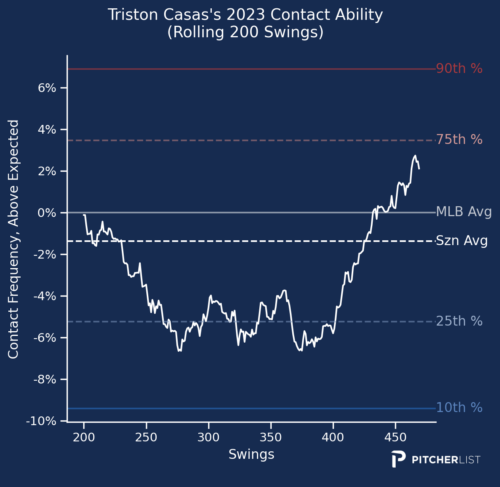
We’ll start this week by surveying the top hitters by Hitter Performance (HP) with a minimum of 400 pitches.
Bradish had a 27.7% K rate in four June starts, along with a 3.54 ERA and 1.04 WHIP. Bradish’s fastball doesn’t stand out with a 3.86 PLA. But his slider’s 0.99 PLA is the best among all pitchers, with at least 500 pitches thrown.
Bello also surged in June with a 2.14 ERA and 0.86 WHIP through five starts. His arsenal is led by an impressive sinker, which has recorded a 3.33 PLA, tied with Framber Valdez for 14th among pitchers with at least 1,000 pitches thrown. However, his slider has skewed more toward the below-average range, which has capped his strikeouts a bit.
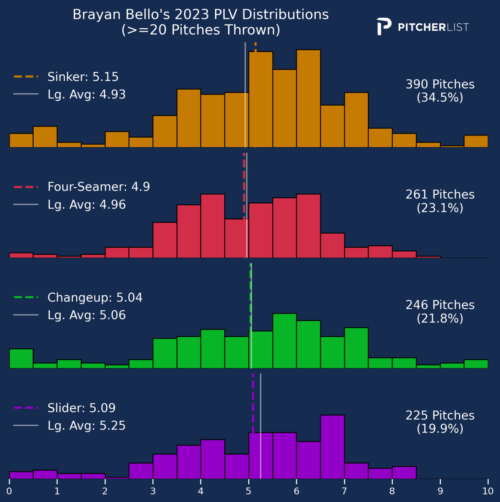
Lynn had a rough-looking start against the Angels his last time out, but he battled his way through six innings while earning the win. The really interesting thing is that he threw 30 sliders. So how did the slider grade? Eh, kind of average-ish — a 26.7% CSW and a 5.04 PLV / 3.80 PLA. Still, that was by far the most he’s thrown in a start, his high being 13, so it could be something to keep an eye on. His cutter continued to grade out really well and earned a 5.39 PLV / 2.72 PLA in his latest start.
Lynn’s fastball has been below average as a whole, with a 4.91 PLV (4.96 is league-average). However, his heater earned impressive grades against the Angels with a 5.42 PLV / 2.61 PLA. That was the heater’s best showing by PLV since his start against the Twins on May 11th (5.50 PLV / 2.20 PLA). What does all this mean? I wish I knew. He’s still missing a ton of bats, which, for better or worse, has me cautiously optimistic. Still, I wouldn’t blame you for cutting ties and making him someone else’s headache.
This past Thursday, Domingo Germán tossed the 24th perfect game in baseball history. Let’s see what the PLV box score said.

As you’d expect, the PLV grades are terrific. I was a little curious to see how many hits PLV predicted, and the answer was six. Germán’s curveball was the star of the show with 5.47 PLV along with a 41.2% CSW. The funny thing about all this is that prior to this masterpiece, Germán had a dud against the Mariners. However, his curveball still showed up reasonably well in that one, with a 35% CSW and 5.23 PLV. You just never know.
Photo by Ric Tapia/Icon Sportswire | Adapted by Justin Paradis (@JustParaDesigns on Twitter)

